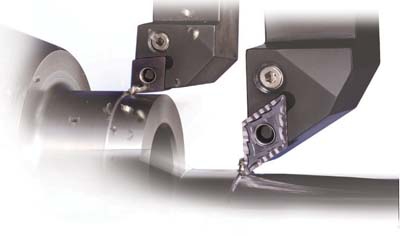
Kyocera Industrial Ceramics Corp., Cutting Tool Division introduced its new PV7025 PVD-coated cermet grade of indexable cutting tool inserts for general machining of steel.
Featuring Kyocera's new proprietary MEGACOAT PVD coating technology, PV7025 offers extraordinary wear resistance and heat resistance, providing superior durability in high-speed machining. When combined with a super micro-grain cermet substrate, the result is an exceptional cutting tool material for steel machining.
Kyocera's MEGACOAT Cermet features several key advantages, including:
MEGACOAT Cermets are less chemically reactive than carbide, which reduces the tendency for built-up-edge and provides improved surface finishes.
MEGACOAT Cermets are capable of running wet or dry, allowing reduced coolant costs and easier recycling of metal chips. Cermet pricing remains stable as compared to the rising cost of tungsten carbide.
PV7025 maintains a Flexural Strength equivalent to P15 Carbide, making it capable of a wide range of cutting depths and feedrates, including continuous roughing to finishing applications.
PV7025 is the most recent addition to Kyocera's MEGACOAT Cermet family. Previously released grades include PV7010 for high-speed finishing of steel and PV7005 for Cast Iron machining.
Contact Details
Related Glossary Terms
- ceramics
ceramics
Cutting tool materials based on aluminum oxide and silicon nitride. Ceramic tools can withstand higher cutting speeds than cemented carbide tools when machining hardened steels, cast irons and high-temperature alloys.
- cermets
cermets
Cutting tool materials based mostly on titanium carbonitride with nickel and/or cobalt binder. Cermets are characterized by high wear resistance due to their chemical and thermal stability. Cermets are able to hold a sharp edge at high cutting speeds and temperatures, which results in exceptional surface finish when machining most types of steels.
- coolant
coolant
Fluid that reduces temperature buildup at the tool/workpiece interface during machining. Normally takes the form of a liquid such as soluble or chemical mixtures (semisynthetic, synthetic) but can be pressurized air or other gas. Because of water’s ability to absorb great quantities of heat, it is widely used as a coolant and vehicle for various cutting compounds, with the water-to-compound ratio varying with the machining task. See cutting fluid; semisynthetic cutting fluid; soluble-oil cutting fluid; synthetic cutting fluid.
- physical vapor deposition ( PVD)
physical vapor deposition ( PVD)
Tool-coating process performed at low temperature (500° C), compared to chemical vapor deposition (1,000° C). Employs electric field to generate necessary heat for depositing coating on a tool’s surface. See CVD, chemical vapor deposition.
- tungsten carbide ( WC)
tungsten carbide ( WC)
Intermetallic compound consisting of equal parts, by atomic weight, of tungsten and carbon. Sometimes tungsten carbide is used in reference to the cemented tungsten carbide material with cobalt added and/or with titanium carbide or tantalum carbide added. Thus, the tungsten carbide may be used to refer to pure tungsten carbide as well as co-bonded tungsten carbide, which may or may not contain added titanium carbide and/or tantalum carbide.
- wear resistance
wear resistance
Ability of the tool to withstand stresses that cause it to wear during cutting; an attribute linked to alloy composition, base material, thermal conditions, type of tooling and operation and other variables.






